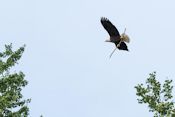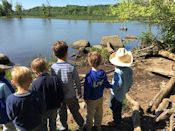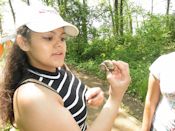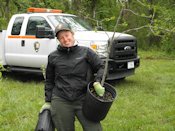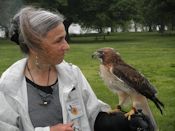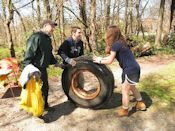There is one active bald eagle nest in the Dyke Marsh Wildlife Preserve this spring, 2017, confirmed by a National Park Service biologist’s helicopter survey conducted before trees leafed out. Our fingers are crossed for some fledged young. Bald eagles that hatch in April in this area usually can fly and leave the nest in early June.
News
Forty pre-schoolers from St. Luke's Episcopal Church Day School, Mount Vernon area, visited the Dyke Marsh Wildlife Preserve on May 8, 2017, with their teachers. The youngsters had a scavenger hunt and looked for birds, shells, gum balls, paw prints, cattails and critters.
Thirty youngsters from Washington, D.C., Inspiring Connections, all students at Caesar Chavez Public Charter School for Public Policy and their three D.C. Sierra Club chaperones, learned all about freshwater wetlands and the flora and fauna of the Dyke Marsh Wildlife Preserve on April 29.
On a damp, overcast, 55-degree morning, eight volunteers and two National Park Service staffers planted 50 native shrubs and trees along the Haul Road in Dyke Marsh in the section of the wetland between the “dogleg” and the boardwalk. Most of the plants are facultative, meaning edge plants or plants that grow in wetlands but can survive in non-wetlands.
Despite gray skies and a steady drizzle, around 200 raptor fans -- young, old and in between -- enjoyed FODM’s annual Raptor Rapture on April 22, 2017, in Belle Haven Park. Liz and Tim Dennison from Secret Gardens, Birds and Bees brought a red-tailed hawk (Buteo jamaicensis), a barred owl (Strix varia) and a great horned owl (Bubo virginianus), all “rescue birds.”
On April 8, 60 dedicated volunteers collected around 80 bags of trash in the Dyke Marsh Wildlife Preserve, Belle Haven Park, Belle Haven Marina and along the GW Parkway trail and the Potomac River shoreline from 9 a.m. to 12 noon. Items included cigarette butts, bottle tops, plastic bottles, whiskey bottles, a fishing rod, a soaked sleeping bag, two rubber tires (one from a tractor trailer truck), fast food debris, various balls and much Styrofoam and miscellaneous plastic.

